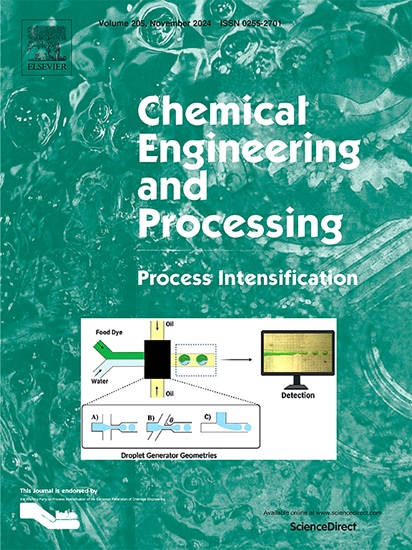利用高性能旋转反应器强化剥离和吸收处理垃圾渗滤液中的氨
IF 3.9
3区 工程技术
Q3 ENERGY & FUELS
Chemical Engineering and Processing - Process Intensification
Pub Date : 2025-05-02
DOI:10.1016/j.cep.2025.110348
引用次数: 0
摘要
在粮食生产不断增长的推动下,全球对氮的需求不断增加,这凸显了从废水中高效回收氨的必要性。垃圾渗滤液处理不当不仅会造成环境问题,还会导致宝贵氮的流失。本研究探讨了高性能旋转反应器(HP2R)与洗涤装置相结合对垃圾渗滤液中氨的去除和回收。考察了在900转/分恒转速下,气流量(QG)、渗滤液流量(QL)和渗滤液温度(TLi)对氨去除率(η去除率)和回收率(η回收率)的影响。达到95% η去除率的总渗滤液循环时间为1.5 ~ 4 h,对应的KLa变化范围为0.74 ~ 2.48 h-1。受气相氨浓度的影响,η回收率在67.1% ~ 84.8%之间波动。确定了η去除率95%,η回收率80%的最佳操作条件为:QG为200 L/min, QL为0.2 L/min,转速为900 rpm, TLi为30 ~ 40℃。回收了高浓度氨(1930-3360 mg/L)溶液,为氨生产提供了一种潜在的替代来源。本文章由计算机程序翻译,如有差异,请以英文原文为准。

Ammonia removal and recovery from landfill leachate via intensified stripping and absorption using a high-performance rotating reactor
The increasing global demand for nitrogen, driven by growing food production, highlights the need for efficient ammonia recovery from wastewater. Inadequate treatment of landfill leachate not only causes environmental issues but also results in the loss of valuable nitrogen. This study investigates the use of a High-Performance Rotating Reactor (HP2R) combined with a scrubber unit for ammonia removal and recovery from landfill leachate. The effect of gas flow rate (QG), leachate flow rate (QL), and leachate temperature (TLi) on the ammonia removal (ηremoval) and recovery efficiency (ηrecover) at a constant rotating speed of 900 rpm was evaluated. The total leachate recirculation time to achieve 95 % of ηremoval was from 1.5 to 4 h, corresponding to the variation of KLa from 0.74 to 2.48 h-1. The ηrecover fluctuated from 67.1% to 84.8 %, influenced by ammonia concentration in the gas phase. The optimal operational condition to achieve 95 % of ηremoval and 80 % of ηrecover was defined at QG of 200 L/min, QL of 0.2 L/min, rotational speed of 900 rpm, and TLi of 30–40 °C. High ammonia concentrations (1930–3360 mg/L) solution were recovered, presenting a potential alternative source for ammonia production.
求助全文
通过发布文献求助,成功后即可免费获取论文全文。
去求助
来源期刊
CiteScore
7.80
自引率
9.30%
发文量
408
审稿时长
49 days
期刊介绍:
Chemical Engineering and Processing: Process Intensification is intended for practicing researchers in industry and academia, working in the field of Process Engineering and related to the subject of Process Intensification.Articles published in the Journal demonstrate how novel discoveries, developments and theories in the field of Process Engineering and in particular Process Intensification may be used for analysis and design of innovative equipment and processing methods with substantially improved sustainability, efficiency and environmental performance.

 求助内容:
求助内容: 应助结果提醒方式:
应助结果提醒方式:


